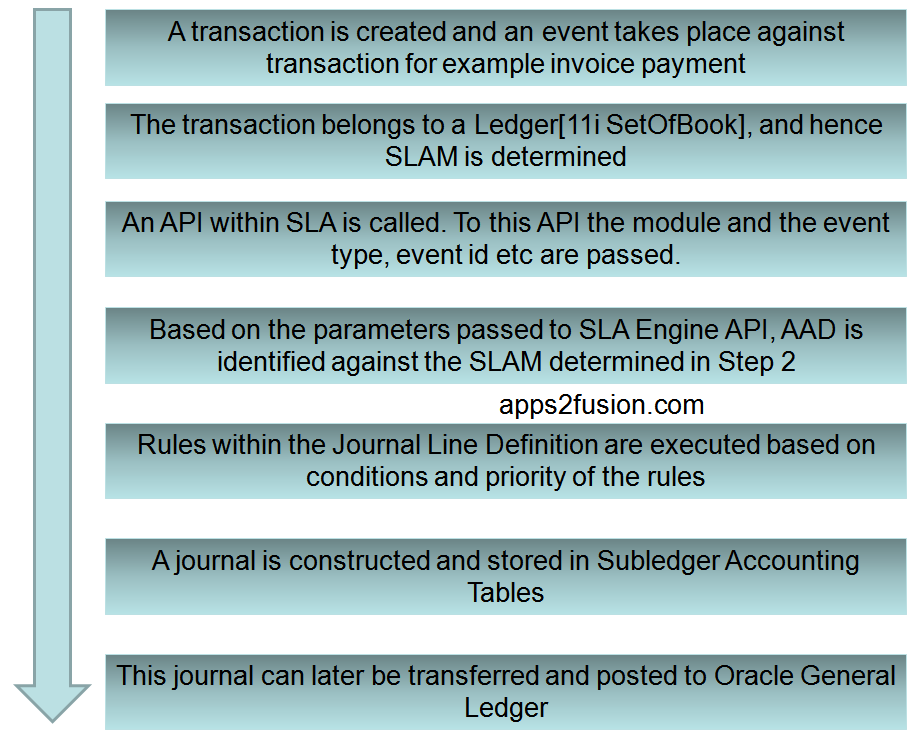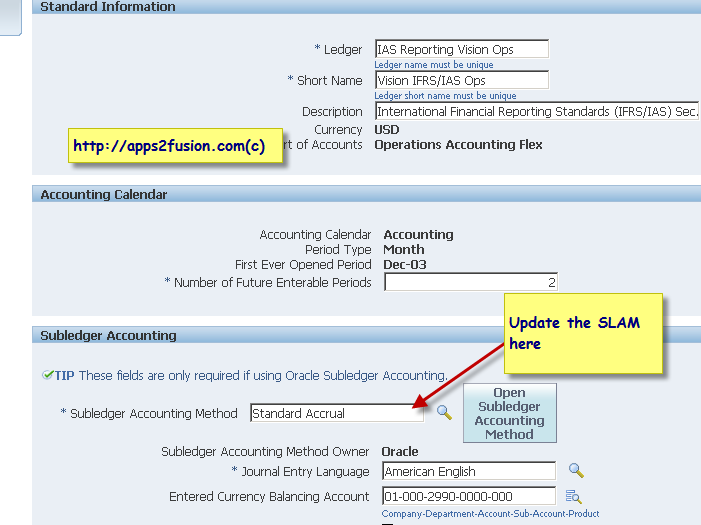As we have seen in the Part 4 of SLA, the Application Accounting definition is used to decide two thingsa. When a specific event within Subledger example Payables or Receivables becomes eligible for Accounting
b. How the journal is constructed.
However, each Primary Ledger[ 11i equivalent of primary set of book] and also each secondary ledger should be able to generate Journals as per their respective legislator requirements for all the modules implemented. This is where "Subledger Accounting Method" [SLAM] comes into the play. If you recollect from previous article, Application Accounting Definition is connected to only one module like Payables or Receivables etc. However a Ledger[11i SOB equivalent] needs accounting entries to be processed across many modules. Hence SLAM provides an umbrella to join accounting entries from various modules so that they can be channelled through to Oracle General Ledger. In other words a SLAM is a collection of accounting definitions for various modules in Oracle Apps. A SLAM is then attached to the Ledger[11i equivalent of Set Of Books].
Therefore the flow of accounting entries appears as shown below

The flow represented in simple equation appears as below
Ledger Defined in GL-->SLAM-->AAD--> [Event Class and Event Type]-->Liability Lines-->[JED+JLT+ADR]
Ledger Defined in GL-->SLAM-->AAD--> [Event Class and Event Type]-->Expense Lines-->[JED+JLT+ADR]
In order to assign the SLAM to a ledger, go to the General Ledger Super User responsibility and click on menu as shown below.

Click on update against the ledger

Attach the SLAM to this ledger

You can also modify the SLA accounting options using the two screenshots as shown below
b. How the journal is constructed.
However, each Primary Ledger[ 11i equivalent of primary set of book] and also each secondary ledger should be able to generate Journals as per their respective legislator requirements for all the modules implemented. This is where "Subledger Accounting Method" [SLAM] comes into the play. If you recollect from previous article, Application Accounting Definition is connected to only one module like Payables or Receivables etc. However a Ledger[11i SOB equivalent] needs accounting entries to be processed across many modules. Hence SLAM provides an umbrella to join accounting entries from various modules so that they can be channelled through to Oracle General Ledger. In other words a SLAM is a collection of accounting definitions for various modules in Oracle Apps. A SLAM is then attached to the Ledger[11i equivalent of Set Of Books].
Therefore the flow of accounting entries appears as shown below
The flow represented in simple equation appears as below
Ledger Defined in GL-->SLAM-->AAD--> [Event Class and Event Type]-->Liability Lines-->[JED+JLT+ADR]
Ledger Defined in GL-->SLAM-->AAD--> [Event Class and Event Type]-->Expense Lines-->[JED+JLT+ADR]
In order to assign the SLAM to a ledger, go to the General Ledger Super User responsibility and click on menu as shown below.
Click on update against the ledger
Attach the SLAM to this ledger
You can also modify the SLA accounting options using the two screenshots as shown below
No comments:
Post a Comment